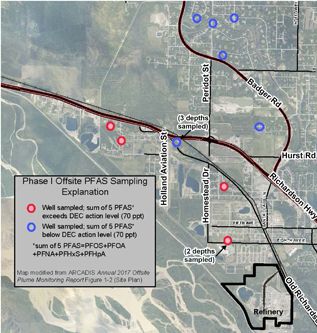Fact Sheet Oct. 2018: PFAS Investigation in North Pole Area Groundwater
October 3, 2018 - NOTE: the latest version of this fact sheet is dated Sep. 29, 2020.
Contents
- Overview
- Sampling Design
- Drinking Water Well Results
- Groundwater Monitoring Well Results
- Map
- Next Steps
- DEC's Action Levels
- Contacts
See the PDF version of this fact sheet.
Overview
The discovery of PFAS, or per- and polyfluoroalkyl substances, in drinking water systems has been drawing recent attention nationwide, statewide and locally in the Fairbanks area. PFAS are man-made chemicals that have been used in industry and consumer products worldwide since the 1950s. PFAS are manufactured for their heat, water, and stain-resistant properties, and applications include non-stick cookware, water- and stain-repellent fabrics, and firefighting foams. PFAS do not easily break down in the environment and travel rapidly to groundwater, where they can spread.
The Department of Environmental Conservation (DEC) has recently set action levels for six PFAS in drinking water supplies. The action levels will be used to determine when treatment of water or an alternative water supply (such as bottled water or other drinking water supplies) is needed to protect human health. Because the research on these compounds is still evolving, DEC is using currently available science to set protective levels, which, if exceeded, trigger the need to provide treatment or alternative water. On October 1, DEC announced a proposed regulation update to establish cleanup levels in regulation for these six PFAS.
- More information below on DEC’s Technical Memorandum setting the action levels.
- More information on PFAS and DEC’s action levels.
- More information on the proposed changes to the regulations for PFAS.
PFAS Sampling Design
This summer, DEC took advantage of an existing monitoring program and sampled a small number of water wells in the North Pole area for PFAS. Test wells for this preliminary sampling were selected to look for PFAS across a wide range of groundwater conditions. DEC is aware that fire-fighting foams containing PFAS were historically used on the former North Pole Refinery property. The purpose of this summer’s monitoring was to evaluate PFAS in groundwater off the refinery.
Residents and businesses in the sampling area are currently being provided with alternative drinking water supplies or point of entry (POE) water treatment systems for sulfolane removal.
For the PFAS sampling, DEC selected:
- 4 private water wells fitted with POE treatment systems, and
- 9 groundwater monitoring wells.
From each private water well, DEC collected two samples: an untreated and a treated water sample. DEC collected one sample from each groundwater monitoring well.
Drinking Water Well Results
POE Treatment systems are effectively removing PFAS to below DEC action levels.
- Untreated water sample results indicate a PFAS plume in the area.
- PFAS were detected in all samples of water taken prior to treatment; two results were above the DEC action levels.
- Post-treatment samples show PFAS below the DEC action levels.
- In three of the treated water samples, PFAS were not detected. PFAS were detected at concentrations far below DEC action levels in one sample.
GroundWater Monitoring Well Results
- 3 of the sample results were above DEC action levels,
- 6 of the sample results were below the action levels.
Map
The drinking water well and groundwater monitoring well results are shown on this map.
Next Steps
DEC is currently planning a second phase of PFAS sampling in the North Pole area to be performed before the end of 2018.
Additional drinking water wells with POE treatment systems will be sampled to confirm the effectiveness of the systems in removing PFAS.
DEC will sample additional groundwater monitoring wells and private wells to assess the boundaries of the PFAS groundwater plume and provide more information on the source of PFAS in the groundwater.
DEC's Action Levels
In August of 2018, DEC issued the Technical Memorandum: Action Levels for PFAS in Water and Guidance on Sampling Groundwater and Drinking Water. These levels determine when treatment or alternative water supply is necessary to protect human health. DEC has set action levels for the following six individual PFAS:
- perfluorooctane sulfonic acid (PFOS)
- perfluorooctanoic acid (PFOA)
- perfluorononanoic acid (PFNA)
- perfluorohexanesulfonic acid (PFHxS)
- perfluoroheptanoic acid (PFHpA)
- perfluorobutanesulfonic acid (PFBS)
The action level is 70 parts per trillion (ppt) – for the sum of PFOS, PFOA, PFNA, PFHxS, and PFHpA. This means that the sum of the concentrations of all these contaminants, or those that are present, cannot exceed the action level. The current action level for PFBS differs, and is set at 2,000 ppt.
Contacts
Assessment and Cleanup
- Alaska Department of Environmental Conservation
- Division of Spill Prevention and Response
- Contaminated Sites Program
- Jim Fish
- Environmental Project Manager
- 907-451-2117
Health-related Information (updated May 8, 2023)
- Alaska Department of Health
- (Formerly "Alaska Department of Health and Social Services)
- Division of Public Health
- Andrew Cyr
- Public Health Specialist
- 907-269-8054


 Indicates an external site.
Indicates an external site.